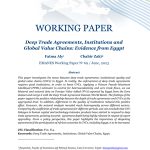
EMANES Working Paper No 68
Using dyadic trade data and bilateral aid for trade (AfT) figures from the OECD Creditor Reporting System (CRS) for a sample of 155 countries over the period 2002-2019, we implement a gravity analysis, to assess whether bilateral aggregate AfT and AfT for trade policy and regulation flows have managed to bolster exports of AfT-recipient countries to donors. We also examine if the institutional distance between recipients and donor countries affected the efficacy of AfT in promoting the former’s bilateral exports. When accounting for the large heterogeneity amongst recipient countries, in terms of geographical location and income level, our investigation yields the following results: i) AfT flows tend to foster exports of recipients, both at the extensive margin (AfT augments the recipients’ likelihood of exporting) and intensive margin (AfT stimulates the recipients’ exports); ii) the trade-stimulating effect of AfT for trade policy and regulation is more pronounced than that of aggregate AfT flows; iii) institutional disparities between trading partners dampens the effectiveness of AfT in promoting exports at both margins of trade; and iv) the stimulating effect of AfT on trade in recipient countries varies with their geographical location and income level. Our findings suggest that i) allocating aid flows, notably the ones targeting trade policy reforms, are likely to speed-up the insertion of developing countries into world markets; and ii) strengthening governance in AfT-beneficiary countries and closing their institutional gap with donors would enhance the effect of AfT on their exports.





